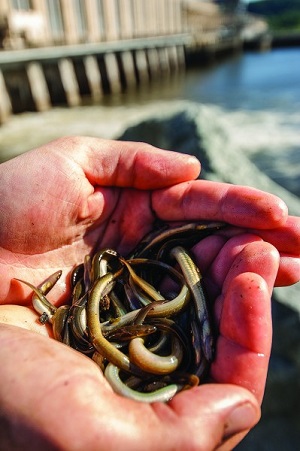 Biologists trucked 58,344 migrating eels past four dams on the lower Susquehanna River this year and turned them loose upstream so they could complete their journey into upstream tributaries. That was the least number of eels in the last four years — 275,479 were trucked upstream in 2013 alone — but an improvement over the early years of the effort. The U.S. Fish and Wildlife Service began trucking eels upstream in 2008. It transported only 17,504 that year.
Biologists trucked 58,344 migrating eels past four dams on the lower Susquehanna River this year and turned them loose upstream so they could complete their journey into upstream tributaries. That was the least number of eels in the last four years — 275,479 were trucked upstream in 2013 alone — but an improvement over the early years of the effort. The U.S. Fish and Wildlife Service began trucking eels upstream in 2008. It transported only 17,504 that year.
Normally, large numbers of eels move upstream in pulses, often coinciding with a new moon, said Steve Minkkinen, who heads the USFWS Maryland Fisheries Resources Office.

But starting in late May, biologists saw a smaller, but steady, stream of eels crawling up the eelway set up just below Conowingo Dam, That stream continued through late July, then tapered off, he said.
“It’s not a terrible year,” Minkkinen said. “But most years, we see between two and five pulses of eels. It was a different year from our other seasons.”
The Susquehanna River was once home to huge numbers of eels, but dams built a century ago closed it to migration. Biologists began trucking eels caught below Conowingo Dam to several upstream tributaries, primarily Pine Creek and Buffalo Creek, in 2008 with hopes of re-establishing eel populations.
Follow-up surveys have shown that eels transported to those sites appear to be doing well, and are expanding to other locations, Minkkinen said. “It’s a good sign they are spreading out,” he said. “That is exactly what we want.”
With those creeks stocked, eels are now being released near Etters, PA, which is past the four hydroelectric dams but a bit south of Harrisburg.
“We have decided that we are going to take them from a riverine environment at the base of the dam, get them up above the four mainstem blockages as quickly as possible and put them back in to migrate like they were,” Minkkinen said. “Let them decide where they want to go.”

Much of the interest in bringing back eels is driven by recent research that has shown that eels are critical for the reproduction of the Eastern elliptio, a freshwater mussel abundant in other rivers, but not in the Susquehanna. The larval stage of freshwater mussels needs to live for a time on a fish “host” before it drops off and begins to grow on its own.
After dams were built and eels disappeared, biologists say there was little evidence of reproduction by the mussels in the Susquehanna, and populations of the water-filtering elliptios have dwindled.
But, Minkkinen said, recent follow-up surveys have found young mussels in Pine and Buffalo creeks, where eels were re-introduced. “That is really promising,” Minkkinen said.
The operating license for the Conowingo Dam, which is owned by Exelon, is up for renewal, and some type of permanent upstream eel passage is expected to be a condition of the new license.
Eels could use the help. Their numbers along the East Coast are near record lows, and the USFWS is determining whether they warrant protection under the Endangered Species Act. A decision is expected in October.
